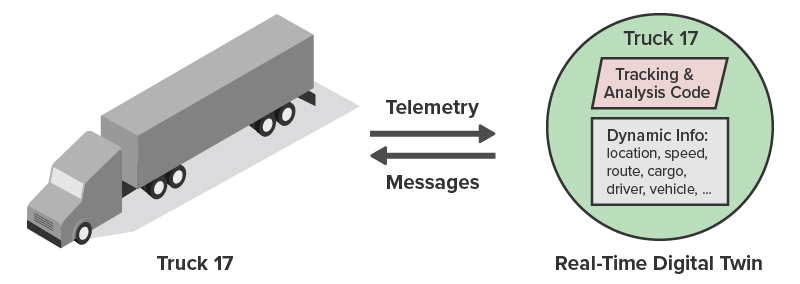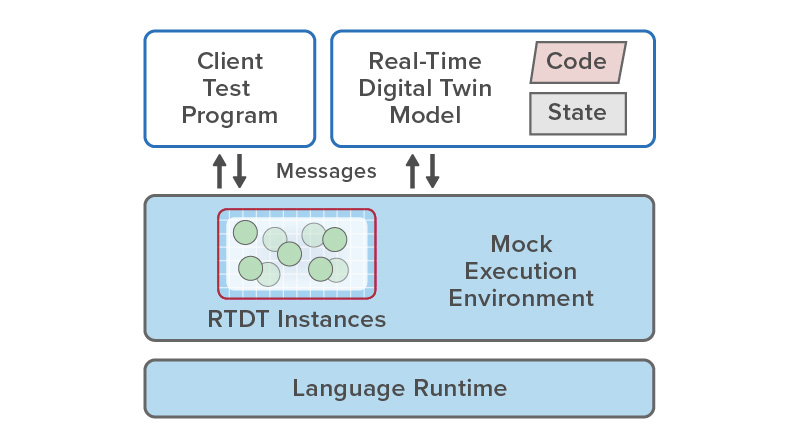Simplifying the Development Process with Mock Environments
This blog post explains how a new software construct called a real-time digital twin running in a cloud-hosted service can create a breakthrough for streaming analytics. Development is fast and straightforward using standard object-oriented techniques, and the test/debug cycle is kept short by making use of a mock environment running on the developer’s workstation.
What Are Real-Time Digital Twins?
The ScaleOut Digital Twin Streaming Service offers an exciting new approach to streaming analytics in applications that track large numbers of data sources and need to maximize responsiveness and situational awareness. Examples include tracking a fleet of trucks, analyzing large numbers of banking transactions for potential fraud, managing logistics in the delivery of supplies after a disaster or during a pandemic, recommending products to ecommerce shoppers, and much more.
The key to meeting these challenges is to process incoming telemetry in the context of unique state information maintained for each individual data source. This allows application code to introspect on the dynamic behavior of each data source, maintain synthetic metrics which aid the analysis, and create alerts when conditions require. To make this possible, the Azure-based streaming service hosts a real-time digital twin for each data source. It describes properties to be maintained for the data source and an application-defined algorithm for processing incoming messages from the data source.
Digital twin models used in product lifecycle management (PLM) or in IoT device modeling (for example, Azure Digital Twins) just describe the properties of physical entities, usually to allow querying by business processes. In contrast, real-time digital twins analyze incoming telemetry from each data source and track changes in its state. Their analysis determines whether immediate action needs to be taken to resolve an issue (or identify an opportunity). Real-time digital twins typically employ domain-specific knowledge to analyze incoming messages, maintain relevant state information, and trigger alerts.
For example, a PLM digital twin of a truck engine might describe the properties of the engine, such as its temperature and oil pressure. A real-time digital twin would take the next step by hosting a predictive analytics algorithm that analyzes changes in these properties. It could use dynamic information about recent usage and service history to determine whether a failure is imminent and the driver should be alerted, as shown below:

Implementing Real-Time Digital Twins
Real-time digital twins are designed to be easy to develop and modify. They make use of standard object-oriented concepts and languages (such as C#, Java, and JavaScript). A real-time digital twin consists of two components implemented by the application: a state object which defines the properties to be maintained for each data source, and a message-processing method, which defines an algorithm for analyzing incoming messages from a specific data source. The method contains domain-specific knowledge, such as a predictive analytics algorithm for truck engines. These two components are referred to as a real-time digital twin model, which serves as a template for creating instances, one for every data source.
To simplify development, the ScaleOut Digital Twin Streaming Service provides base classes that can be used to create real-time digital twins and then submit them to the cloud service for execution, as illustrated in the following diagram:

Once the real-time digital twin model has been uploaded, the streaming service automatically creates an instance for every data source and forwards incoming messages from that data source to the instance for processing. Data sources can send messages to their corresponding real-time digital twin instances (and receive replies) using message hubs or a built-in REST service.
Debugging with a Mock Environment
Although these models are simple and easy to build, the number of steps in the deployment process can make it cumbersome to catch coding errors in the early stages of model development. To address this challenge and enable rapid model testing within a controlled environment (for example, within Visual Studio running on a development workstation), the streaming service provides an alternative execution platform, called the mock environment, which can be targeted during development. This environment runs standalone on a workstation and allows an application to create a limited number of real-time digital twin instances. It also provides an API for sending messages to instances and for receiving replies using the same message-exchange protocol that would be used with the cloud-based REST service.
The mock development environment is shown below:

Once a model has been created, it can be tested using a client test program that sends messages that simulate the behavior of one or more data sources. This exercises the model’s code and surfaces issues and exceptions, which can be readily examined and resolved in a controlled environment. When the model behaves as expected, it can then be deployed to the streaming service for execution with live data sources. Note that the model’s code can log messages, which are available for reading in the mock environment and are displayed in the streaming service’s web UI after the model is deployed.
Summing Up
Real-time digital twins offer an important new tool for analyzing telemetry streams from large numbers of data sources, providing immediate feedback for each data source, and maintaining real-time aggregate statistics that boost situational awareness. Unlike PLM-style digital twins, which host the properties of a physical data source for downstream analysis, real-time digital twins provide a means to analyze and respond to a data source’s telemetry within milliseconds, while exposing aggregate trends within seconds. Their functionality fills an important gap in streaming analytics, namely tracking thousands or even a million data sources with fast, individualized feedback.
Amazingly, the power of real-time digital twins can be harnessed with a small amount of application code that contains domain-specific knowledge. The streaming service takes care of all the complexities of message delivery, accessing state data, scaling for thousands of data sources, and high availability. By using a mock development environment, application developers can quickly create, debug, and test real-time digital models prior to their deployment in production. This powerful new approach to streaming analytics solves an important unmet need and offers an impressive combination of power and ease of use.
For detailed information on building real-time digital twin models and using a mock environment, please consult the ScaleOut Digital Twin Streaming Service User Guide.
